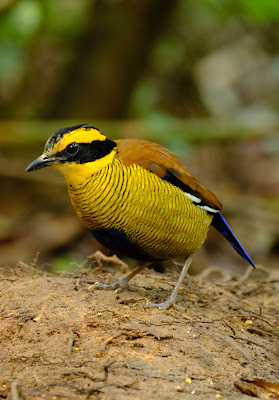We were on our first day tour to KNP with Ikwan in the afternoon After lunch at the canteen we headed to upper Silau-silau trail . This is the regular section to see the Whiteheads. The valley trail is protected from strong wind and I think it is ideal for birds to roost. After failing to spot the bird for 2 hours we decided to walk back to Ligawu which was already pass 4pm. Then we saw excitement from our guide who have returned to usher us back up telling us the Trogon was spotted. And here we go puffing and huffing in quick steps up to the locale; & walla we managed to see this lifer with swelling relieve as we thank the other bird guide who contacted Ikwan. So at times it is good to have some one local to guide you.
The female was also nearby but no good pictures.
So happy that night I send a photo to Theresa to tell her my encounter. The last time I was birding with her and her girl team we did not manage to see it. Hope she manage to see hers already. So in the month of September - October is a good time to bird here. However in 2022 saw the monsoon rain arriving early. On our third day in KNP was a wash out as we wasted a whole wet day

Whitehead's trogon (Harpactes whiteheadi) is a species of bird in the family Trogonidae. It is endemic to the island of Borneo, where it is an uncommon resident in primary mountain forest. One of Borneo's largest trogons at 29 to 33 cm (11 to 13 in) long, it is sexually dimorphic. The male is crimson on the head, nape, and underparts, with a black throat and grey chest; the rest of his upperparts are cinnamon-coloured. The female is similarly patterned, but cinnamon-brown where the male is scarlet. The species was first described for science by Richard Bowdler Sharpe in 1888, who named it for British explorer and collector John Whitehead. There are no subspecies.
(Wiki)
l
Like most trogons, Whitehead's trogon is sexually dimorphic namely the partners are different in apparent; the male is considerably more colorful than the female. It ranks among Borneo's largest trogons, measuring 29 to 33 cm (11 to 13 in) in length. The male is crimson on the forehead, crown, nape, and sides of the head, with bare blue skin around the eyes. The rest of his upperparts are cinnamon-brown. His throat is black, shading into a grey breast, but the rest of his underparts are crimson. His wings are primarily black, with fine white barring on the secondaries and coverts. His tail is mostly white underneath; above, the two central tail feathers are cinnamon with a broad black tip, and the remaining tail feathers are primarily black. The outermost tail feathers are white on the terminal half and along the outer web. He has a blue beak, pinkish-brown legs and feet, and reddish-brown irises. The female is similarly patterned, but duller, with cinnamon-brown replacing the crimson of the male. The barring on her secondaries and wing coverts is cinnamon-brown rather than white. The immature female is similar to the adult female, but her entire ventral side is uniformly coloured, lacking the adult's black throat and grey upper breast. She also has less blue colouring on her beak.









.JPG)









































